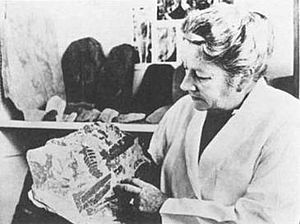Edna P. Plumstead facts for kids
Quick facts for kids
Edna P. Plumstead
|
|
|---|---|
 |
|
| Born | 15 September 1903 |
| Died | 23 September 1989 (aged 86) |
| Alma mater | Witwatersrand University |
| Scientific career | |
| Institutions | Bernard Price Institute for Palaeontological Research, University of the Witwatersrand |
| Author abbrev. (botany) | Plumst. |
Edna Pauline Plumstead (born Janisch) was a famous South African scientist. She was born in Cape Town on September 15, 1903, and passed away in Johannesburg on September 23, 1989.
Edna was a palaeobotanist. This means she studied ancient plants from fossils. She worked at the Bernard Price Institute for Palaeontological Research at the University of the Witwatersrand in Johannesburg. She graduated from this university in 1924.
When she was young, Edna lived in Cape Town. She loved exploring and finding wild flowers. Later, she noticed that these flowers were similar to plants found in places like Australia and South America. This observation helped her support the idea of continental drift.
She started defending the theory of continental drift in the 1950s. She is known as one of South Africa's top scientists in the study of Gondwana (an ancient supercontinent) and geology. Edna Plumstead received the Chrestian Mica Gondwanaland Medal. This award was given by the Geological Society of India. She also became a Fellow of the Royal Society of South Africa.
Edna Plumstead earned her B.Sc. (Hons.) degree in geology in 1924. She then joined the Geology Department at the Witwatersrand University. Her master's degree project was highly praised. It led to her being the first person to receive the Corstorphine Medal. In 1965, she moved to the Bernard Price Institute.
At that time, she was studying plant fossils from Antarctica. She became convinced that rocks of the same age in Antarctica, South Africa, South America, India, and Australia had very similar plant fossils. These plant species were from the late Palaeozoic era.
This was before most scientists accepted the ideas of 'continental drift' or plate tectonics. However, some saw the Antarctic plant fossils as strong proof. They suggested that a huge ancient continent called Gondwana once existed. About five years after Edna shared her fossil evidence, another scientist, James Kitching, added more proof. He found vertebrate (animal) fossils in Antarctica that were identical to those in the Karoo region of South Africa.
Her Important Work
Edna Plumstead lived in Africa, where the idea of Wegener's continental drift was taught. This was different from North America and Europe, where the idea was often rejected. She was very interested in Wegener's theory. She wondered why early life on Earth was found in specific zones.
She also learned about the ancient continent called Gondwana. She decided to study it more deeply. In 1952, she made her most important discovery. She found the reproductive parts of Glossopteris. This plant was very common in Gondwana during the Permian period. She became an expert on this plant.
During her research, she compared plants from the Southern and Northern Hemispheres. She noticed that countries like Africa, South America, India, Australia, and Antarctica had similar plants in the past. This observation was important. It helped prove that Gondwana once existed. You can read about her findings in her book, "The Case for Continental Drift."
For her research, she asked two big questions. The first was: "If continents hadn't moved, how could the same plants have crossed wide oceans to reach different places, but not reach North America, Europe, and Asia?"
Her second question was: "If climates were the same, how can we explain that fossil plants in India are similar to those in Australia, Africa, Argentina, and Brazil, and especially to those found in Antarctica, where no plants can grow today?"
Plumstead also helped develop the theory of mobilism. This theory explains how continents move. She provided new information about Glossopteris. This helped scientists understand how Gondwana broke apart. She became a strong voice for the idea of moving continents.
Her work, along with that of Wegener, du Toit, and Martin, helped Warren Hamilton. Hamilton supported continental drift. He used their work to develop his own theory of mobilism, which he applied to America.
Plumstead was the first to describe the unusual fertile structures of the Glossopteris plant. She found them connected to the leaves. In her review of "Paleobotany in Antarctica," she concluded that the evidence from Antarctica clearly showed that continents must have drifted.
As a paleobotanist, she studied fossils. She was especially interested in how fossils of the same species ended up on different continents. She used the idea of Gondwana to explain this. Her papers on continental drift were widely discussed. They were very important for her own fossil research.
Warren Hamilton, a supporter of mobilism, went to Africa to find evidence for his theory. While there, he read Plumstead's work. Thanks to her (and two other scientists), he was able to prove his theory of mobilism. Plumstead made a huge contribution to understanding Glossopteris. She provided key evidence that confirmed the idea of Gondwana's movement. Because of Plumstead's hard work, other scientists have been able to confirm their own theories. This has helped us learn so much about our world today.

